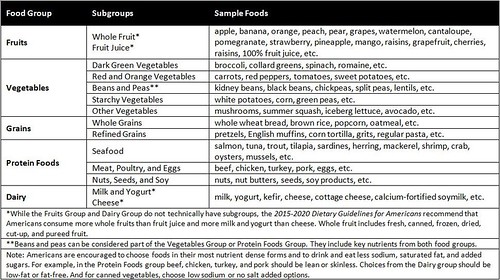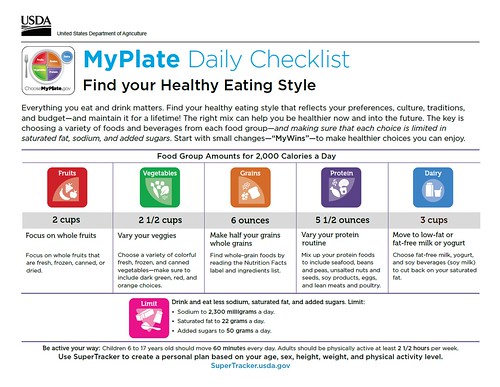
Do you remember learning about the food groups in school? You may have been taught using the Food Wheel, Food Guide Pyramid or MyPyramid depending on your age. Kids today learn about the food groups from MyPlate. Now that the back-to-school season is settling down, the nutritionists at MyPlate are offering a back-to-basics refresher lesson on the food groups.
The Five Food Groups
As the MyPlate icon shows, the five food groups are Fruits, Vegetables, Grains, Protein Foods, and Dairy. The 2015-2020 Dietary Guidelines for Americans emphasizes the importance of an overall healthy eating pattern with all five groups as key building blocks, plus oils. (While oils are not a food group, they are emphasized as part of a healthy eating pattern because they are a major source of essential fatty acids and vitamin E). Each food group includes a variety of foods that are similar in nutritional makeup, and each group plays an important role in an overall healthy eating pattern. Some of the food groups are broken down further into subgroups to emphasize foods that are particularly good sources of certain vitamins and minerals. For example, the subgroups within the Grains Group encourage whole grains, which provide more fiber, magnesium, and zinc than refined grains.

Purpose of Food Groups
As nutrition science has progressed over time, scientists have discovered vitamins, minerals, and other components that make up our foods, and surely, there are more yet to be discovered. Food groups simplify dietary recommendations by focusing on foods instead of nutrients. For example, it’s much easier to try to eat two cups of fruit a day than 75 milligrams of vitamin C and 25 grams of fiber. The USDA Food Patterns provide the recommended amounts of each food group and subgroup at 12 different calorie levels, ranging from 1,000 to 3,200. These patterns are developed using food pattern modeling. By eating recommended amounts, individuals can meet their nutritional needs without having to track dozens of individual nutrients.
Food Group Amounts
The USDA Food Patterns specify targets for each food group in cup equivalents (for Fruits, Vegetables, and Dairy) and ounce equivalents (for Grains and Protein Foods). Each pattern also includes a limited number of calories (8-19%) that can be used in other ways, such as small amounts of added sugars and saturated fats. Americans are encouraged to choose foods in their most nutrient dense forms as often as possible, to keep added sugars and saturated fat intakes each below 10 percent of total calorie intake.
Teaching the Food Groups
ChooseMyPlate.gov offers numerous food group-based nutrition education resources, including tip sheets, videos, food group quizzes, infographics, and more. Plus, MyPlate offers audience-specific resources as well. For example, there are activity sheets, games, videos, and songs for children; activities for families; healthy eating on a budget resources; and MiPlato tipsheets and resources for Spanish speakers.
To learn more about MyPlate and to find out when new resources are available, follow @MyPlate on Facebook or Twitter and sign up for MyPlate email updates at ChooseMyPlate.gov/govdelivery.

